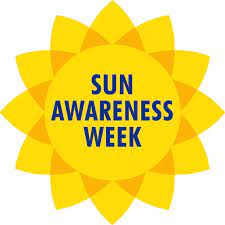Sun Awareness Week 2023 will run from Monday 1st to Sunday 7th May. This year the focus is on most common sun cream myths. To highlight this week Cancer Focus are facilitating an information session on “Sun Awareness” on Wednesday 17th May at 10am -10.30am. To register to receive your MS Teams link please email health.improvement@belfasttrust.hscni.net.
Dermatology Outpatients Department and Cancer Focus are having an information stand on Wednesday 3rd May at Elliot Dynes, RVH. Freebies and sun awareness information will be available.
Most Common Sun cream Myths
As the days get longer, the good weather of spring and summer is beginning to peak around the corner and we’ll all be outdoors more with friends and family in no time.
Cancer Focus Northern Ireland, alongside the Public Health Agency, as part of Sun Awareness Week (1 May – 7 May), are encouraging people to stay safe in the sun and be UV aware. With this in mind, they want to highlight some of the most common myths around sunscreen and tanning to ensure you can be better informed to take all the action required to protect your skin from damage.
Even here in Northern Ireland, it’s crucial that we keep ourselves protected from the sun at all times.
Myth 1: We don’t need to use sunscreen in Northern Ireland.
Many people think if the sun is not splitting the trees, sun protection isn’t required! This is not true. Even on cool or cloudy days in Northern Ireland we need to protect our skin against UV rays as these still filter through the clouds.
Myth 2: You only need to worry about skin damage if you get severe sunburn.
This is false. UV damage can start before your skin tans or burns. The UV index tells us how much UV radiation is reaching us from the sun and when the index is at 3 or more, we need to protect our skin and eyes.
Myth 3: The sun in Northern Ireland is not strong enough to damage your skin.
This is not true. Skin cancer is the most common cancer in Northern Ireland and 4 out of 5 cases are due to overexposure to UV rays. Between March and October, UV rays from the sun can be strong enough to damage your skin even when it is cool or cloudy.
Myth 4: My skin doesn’t burn so I don’t need to worry about sun safety.
All skin needs protection. Anyone can develop skin cancer, whatever their skin type. If you work outside or spend a lot of time outdoors, you might think your skin is tougher and doesn’t need protection, but UV damage can still occur.
Myth 5: Having tanned skin looks healthy.
Having tanned skin shows that your skin has been damaged in the short term. The longer-term effects of UV damage, whether or not you get sunburn, can be premature ageing of the skin, deeper wrinkles, uneven skin pigmentation, age spots, sun spots and an increased risk of skin cancer.
Myth 6: Sunbeds are a good way to get a base tan this summer.
A tan from a sunbed or from the sun is a sign that the skin has been damaged by UV rays and is not a sign of good health. Tanning without a sunburn can still cause premature skin ageing and increase the risk of skin cancer through irreparable DNA damage. Each time skin is exposed to UV rays from the sun or from a sunbed, the risk of developing skin cancer is increased.
Myth 7: Sunscreen is water resistant and should be applied only once a day.
Despite what the packaging states, sunscreen should be applied every two hours, or more frequently if sweating, towelling, or in water. At least six full teaspoonful’s of sunscreen lotion are needed for an all over body application for an average adult.
Before going out into the sun, remember:
- Choose a sunscreen with an SPF 15 or more to protect against UVB, and 4 or 5 stars to protect against UVA.
- Ensure you apply plenty of sunscreen 30 minutes before going outside and reapply every two hours after that and straight after swimming, sweating or towel drying.
- Protect your skin with clothing, like a long-sleeved top to protect your arms, and don’t forget to wear a hat that protects your face, neck, and ears.
- Wear 100% UV protection sunglasses to protect your eyes and make sure you spend time in the shade between 11am and 3pm when the UV rays are at their strongest.
- Always keep babies and young children out of direct sunlight.
- Don’t forget to protect the most common missed spots of sun cream which are eyelids, back of knees, ears, tops of feet, sides of face, hands, scalp, and lips.
It is never too late to start protecting your skin in the sun. Now is the time before the good weather kicks in to get a good routine in place to keep your skin looking good.
For more information regarding looking after your skin in the sun visit www.careinthesun.org.



